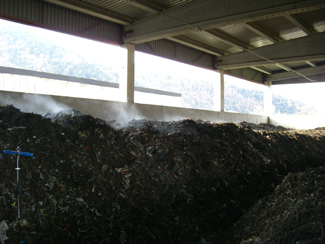
Composting is established as one of the cleanest alternatives to manage our residues. Nevertheless, at industrial scale the composting also takes its disadvantages, as the production of ammonia. New methods of measurement of the biodegradable elements of the compost might solve these problems.
At present, the problems of the treatment of solid waste has a major importance: the pollution provoked by this type of residues, together with their increasing generation, suppose a big challenge for modern societies.
In this frame, the technologies of recycling and biological treatment have an environmental low impact, so they are an alternative recommended at European level for the management and treatment of the residues. Among these technologies, the composting is taking a special relevancy in Catalonia, as can be noticed in the increasing number of plants of composting that have been constructed in the last years. The technology of composting has applied itself normally for residues of domestic origin although there are experiences in the composting of the residues of industrial origin.
One of the most important impacts of the process of composting is the emission of pollutants and foul-smelling gases, which are a cause of atmospheric contamination and of social rejection. Among these emissions, the most out-standing is ammonia, which normally comes from an inadequate ratio between Carbon and Nitrogen (who knows each other as C/N ratio). Often there is more nitrogen than the needed by the microorganisms responsible of degrading the substrates.
In the search we have carried out, different blends are studied through respirometry, to know with accuracy the quantity of biodegradable carbon in samples of different residues: paper, grass, branches, leaves and food waste. Known the quantity of carbon and biodegradable nitrogen we can calculate the real C/N ratio, that is to say, the proportion of the elements that the microorganisms can actually use. In many cases this proportion is much lower than the relation C/N determined chemically.
At the same time, this search tries to evaluate the difference of carbon that can biodegrade following anaerobic or aerobic paths (metanization and composting) for different types of residues; this will allow to do choose the most adequate technology for every case.
References
Sanchez, Antoni "A kinetic analysis of solid waste composting at optimal conditions", WASTE MANAGEMENT, 27 (6): 854-855 2007

